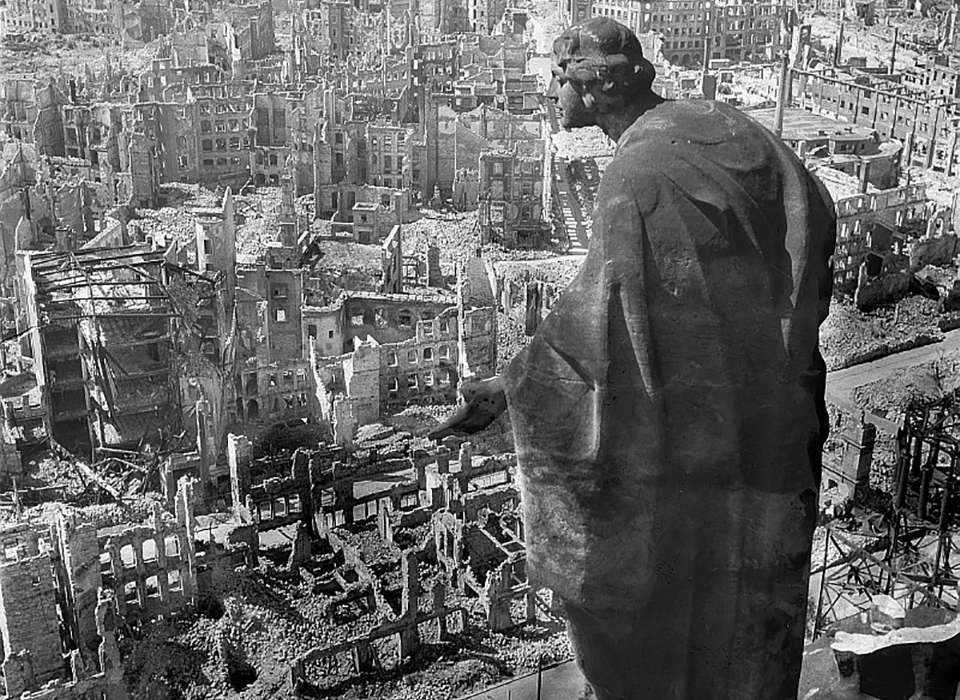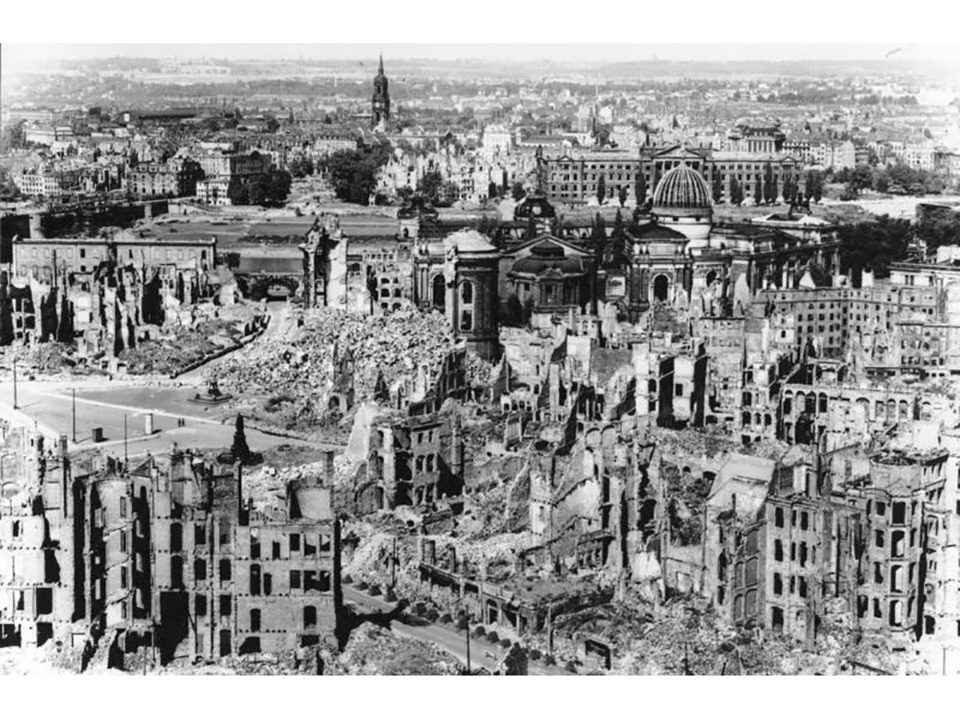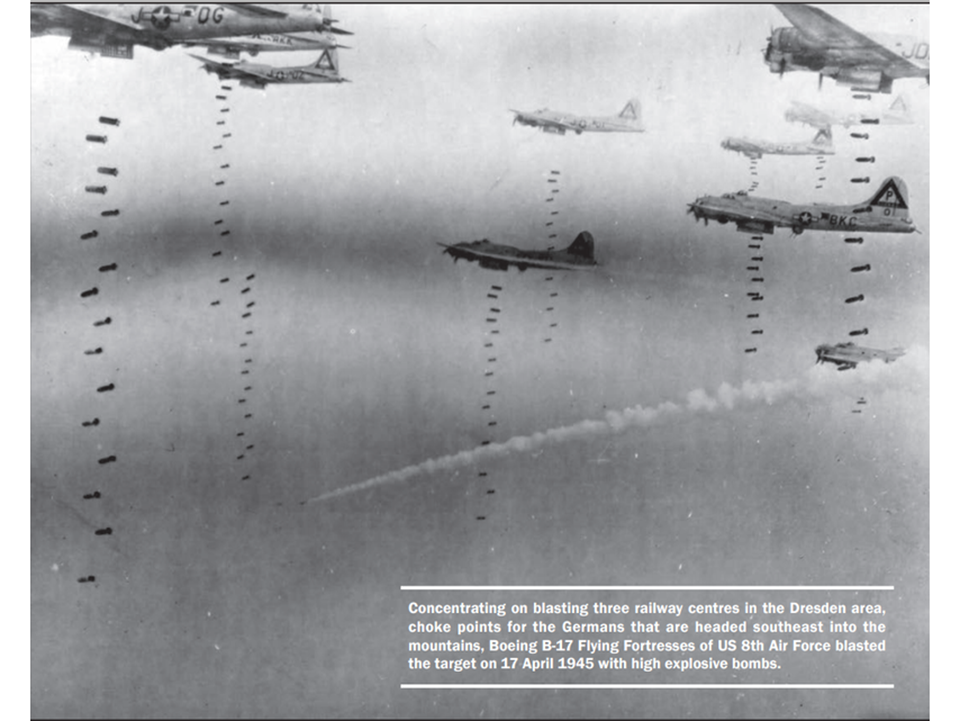The first wave of Lancasters, British four-engined heavy bombers, appeared over Dresden on the night of Tuesday, February 13, 1945, around 10 p.m. After five hours of flight these 240 Royal Air Force (RAF) planes encountered practically no opposition in the skies and no anti-aircraft fire from below. They began an infamous aerial onslaught which devastated the Saxon city.
“Florence on the Elbe,” as Dresden was popularly known, was a strikingly beautiful place. Before World War II people had flocked there to see the 18th-century church, the Frauenkirche (Church of Our Lady). The Zwinger, the impressive palace complex commissioned by Augustus the Strong (1670-1733), Elector of Saxony and King of Poland, pulled in thousands. Lovers of art could devote days to collections of Renaissance and Baroque paintings in the Semper Gallery, including works by Raphael, Titian, Rembrandt, and Van Dyck. During the 19th century the presence of composers Carl Maria von Weber and Richard Wagner established Dresden as a force in the Romantic movement.
Until the attack, Dresden, Germany's seventh largest city with 600,000 inhabitants, had largely escaped the mass destruction inflicted on other urban centers. The United States Army Air Force had bombed it twice—once in early October 1944 and again three months later. The second attack, targeting Dresden’s marshaling yards, had killed scores of workers. Nonetheless, most of Dresden's antiaircraft guns and the crews manning them were relocated elsewhere in the Reich. Although its historic center still stood intact, the city did not escape the impact of the ongoing collapse of the German war effort on the Eastern Front in January and February 1945. About 300,000 men, women, and children desperately fled to Dresden as the Red Army advanced into Silesia. These refugees packed the train stations, terrified of what lay ahead.
Although they had good reason to be terrified, the evacuees and Dresden’s permanent residents indulged in dangerous forms of straw-clutching. The 18-year-old Götz Bergander, who survived the raids in a shelter, later related how rumors proliferated. Some individuals believed that the RAF refused to hit Dresden since an aunt of Winston Churchill supposedly resided somewhere in town. Others claimed that the Allies planned to make it the capital of postwar Germany. Why would the Allies attack a city with such immense cultural treasures, many dared to ask. Some contended a refugee center like Dresden would certainly be spared.
Those delusions quickly withered on February 13, 1945. As Soviet troops moved deeper into eastern Germany, the Allied leadership focused on Dresden, as well as the neighboring Saxon cities of Chemnitz and Leipzig. Air attacks on these sites would degrade the Germans' ability to resist the Soviets. Despite postwar claims that Dresden had no military significance, it was in fact a rail center important to the Third Reich’s faltering war effort in the East. There were also factories engaged in arms production there. Ordered by Deputy Chief of the Air Staff Norman Bottomley to bomb the city, Air Marshal Arthur Harris, head of the RAF's Bomber Command, envisioned massive raids on Dresden. Long wanting to target it, he intended to totally eliminate Dresden's capacity to aid the Wehrmacht. Operation Gomorrah, the RAF’s obliteration of Hamburg in July 1943, provided a fearful precedent. So did the strikes against Kassel in October of that same year, and Darmstadt in September 1944. Tens of thousands of civilians had been killed in these operations. The air offensive against Dresden and other Saxon cities would be a joint operation, though, between the RAF and the United States Eighth Air Force.
Due to uncooperative weather, the Americans could not bomb Dresden during daylight hours on February 13. That meant Harris's bombers would be the first to strike. The unchallenged initial wave of Lancasters dropped a deadly combination of high-explosive bombs and incendiaries on Dresden, beginning at 10:15 p.m. that night. The bombs forced everyone to seek shelter, while the incendiaries started fires. Author Frederick Taylor pointed out how the bomber crews, facing no resistance, found “the weather was also sufficiently benign to allow low-level, accurate marking. The crews themselves, relieved of the necessity of staying toward the limit of flak range, could moreover bomb in a careful and relatively relaxed fashion at a lower altitude than usual, in this case mostly between 10,000 and 13,000 feet.” In a short window of about 15 minutes, they unleashed 880 tons of bombs on Dresden’s city center. The high-explosive weapons shattered windows, gouged out craters in the streets, and flattened walls. Firefighters were forced to take cover. The bombs also set in motion waves of high-pressure air. As the incendiaries falling on the roofs of buildings ignited manifold small fires, a firestorm, one of the most dreadful outcomes of hi-tech warfare, ensued.
What happened then in Dresden, with its structures of brick, sandstone, and dry wood, was apocalyptic. Bergander has left us this unforgettable statement: “There was an indescribable roar in the air—the fire. The thundering fire reminded me of the biblical catastrophes that I had heard about in my education in the humanities. I was aghast. I can’t describe seeing this city burn in any other way. The color had changed as well. It was no longer pinkish-red. The fire had become a furious white and yellow, and the sky was just one massive mountain of cloud.” City authorities usually could count on a thousand firefighters, but the inferno was too much for them and for the relief that came from neighboring cities. Only two-and-a-half hours passed before the populace confronted a second wave of Lancasters.
This group consisted of 550 heavy bombers, more than twice the size of the first wave. Between approximately 1:20 and 1:40 a.m. the Lancasters inundated a city already aflame. The firestorm created in the initial raid now reached a fury of devastation that beggars the imagination. Historian Donald Miller writes vividly of the hell unleashed: “People’s shoes melted into the hot asphalt of the streets, and the fire moved so swiftly that many were reduced to atoms before they had time to remove their shoes. The fire melted iron and steel, turned stone into powder, and caused trees to explode from the heat of their own resin. People running from the fire could feel its heat through their backs, burning their lungs.” Miller also points out a forgotten fact, that 70 percent of the victims actually suffocated from carbon monoxide discharged by combustion. It is no surprise that the German author, Jörg Friedrich, chose to title his controversial book on the Allied bombing of Dresden and other cities simply Der Brand (The Fire).
Yet everyone who survived that night especially recalled the ferocious winds accompanying the fires. In an interview with the Museum’s Keith Huxen, PhD, Freeman Dyson, the eminent physicist and mathematician, reflected on his work as an analyst for the RAF’s Bomber Command. In the case of the assault on Dresden, Dyson said, it was “like a hurricane.” All the conditions for a perfect firestorm coincided.
At noon the following day, Ash Wednesday, more than 300 B-17 Flying Fortresses from the United States Eighth Air Force struck Dresden. With towers of smoke from the RAF attacks still shooting 15,000 feet into the air, the Americans had enormous difficulty finding their targets. They did hit the beleaguered city’s marshaling yard but residential areas were also bombed. And this was not the finale.
On February 15, a fourth raid hit Dresden. More than 200 B-17s, originally sent to destroy an oil plant close to nearby Leipzig, switched targets due to poor weather. The marshaling yards were not hit. The same could not be said about residential areas. Even that did not end Dresden’s torment. The Eighth Air Force returned on March 2 and April 17, again going after the rail yards and industrial districts.
Dresden remained ablaze for weeks. Bergander recalled how unceremoniously the dead were treated. Fear of disease led the Germans to pile the corpses on top of iron grates, soak them with benzene, and cremate them. SS personnel played a key role in creating these makeshift funeral pyres. The smell permeated everything. Allied prisoners of war were forced to help extract bodies from the rubble. We know of at least one case where an American POW was executed, purportedly for looting. Mass graves became the final resting places for thousands. A widely accepted estimate is 35,000 killed during the 37 hours of terror. Rival claims go far higher. The German government, however, proposes 25,000 as a defensible guess. Since so many victims were immolated after the attacks, we will likely never know the precise number.
The February raids turned “Florence on the Elbe” into a ruined necropolis, a city of the dead. The photographs snapped by Richard Peter months after the firestorm have not lost any of their capacity to unsettle. Allied prisoners held in Dresden during the bombing, such as British rifleman Victor Gregg and the American Kurt Vonnegut, whose postwar novel Slaugherhouse Five vividly conveyed the resulting carnage, condemned the attacks. Winston Churchill went so far as to write, "the destruction of Dresden remains a serious query against the conduct of Allied bombing." While there were legitimate military targets in Dresden, how can one sanction the deliberate targeting of the civilian population? Frederick Taylor’s judgment still rings true: “When we think of Dresden, we wrestle with the limits of what is permissible, even in the best of causes.”
Further Reading:
Bergander, Götz. Dresden im Luftkrieg: Vorgeschichte, Zerstörung, Folgen. Würzburg: Böhlau, 1994.
Friedrich, Jörg. The Fire: The Bombing of Germany, 1940-1945. Translated by Allison Brown. New York: Columbia University Press, 2006.
Miller, Donald. Masters of the Air: America’s Bomber Boys Who Fought the Air War Against Nazi Germany. New York: Simon & Schuster, 2006.
Stargardt, Nicholas. The German War: A Nation Under Arms, 1939-1945, Citizens and Soldiers. New York: Basic Books, 2015.
Steinhoff, Johannes, Peter Pechel, and Dennis Showalter. Voices from the Third Reich: An Oral History. Washington, D.C.: Regnery Gateway, 1989.
Taylor, Frederick. Dresden: Tuesday, February 13, 1945. New York: HarperCollins, 2004.
Jason Dawsey, PhD
Jason Dawsey, PhD, is ASU WWII Studies Consultant in the Jenny Craig Institute for the Study of War and Democracy.
Cite this article:
MLA Citation:
APA Citation:
Chicago Style Citation:







![Max Fuchs, New York City cantor, sings as Rabbi Sydney [sic] Lefkowitz, Richmond, VA, conducts the first Jewish services from Germany.](/sites/default/files/styles/max_650x650/public/2025-10/image1.jpg)



